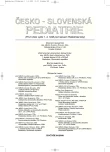Inhaled Nitric Oxide in Treatment of Severe Respiratory Failure in Children
Authors:
L. Marek 1; V. Vobruba 2; P. Košut 1; P. Srnský 2; J. Žurek 1; L. Koudelková 1; L. Košinová 1; M. Fedora 1
Authors‘ workplace:
Klinika dětské anesteziologie a resuscitace, Pracoviště dětské medicíny, Fakultní nemocnice Brno
přednosta doc. MUDr. M. Fedora, PhD.
1; Jednotka intenzivní a resuscitační péče Kliniky dětského a dorostového lékařství Všeobecné fakultní nemocnice, Praha
přednosta prof. MUDr. J. Zeman, DrSc.
2
Published in:
Čes-slov Pediat 2009; 64 (6): 283-295.
Category:
Original Papers
Overview
Objective:
1) To assess impact of iNO on oxygenation and ventilation parameters during artificial lung ventilation (CMV a HFOV) in children with severe acute hypoxic respiratory failure. 2) To asses impact of iNO on ventilator settings. 3) To determine frequency of iNO complication. 4) To evaluate impact of iNO on children’s mortality.
Design:
Prospective observational study.
Setting:
Clinic of Pediatric Anesthesiology and Resuscitation, Faculty Hospital Brno and Clinic of Pediatric and Teen-age Medicine, General Faculty Hospital in Prague.
Material and method:
All study participants met following criteria: Age between 28 days and 18 years, diagnosis of AHRF based on ARDS and protective CMV or HFOV failure. Exclusion of patients with congenital heart disease comorbidity was applied. All patients were treated according to ALI/ARDS protocol used in both before-mentioned departments since 1997. This protocol includes protective CMV (with optimized PEEP, recruitment manoeuvres and permissive hypercapnia), prone position, TGI, HFOV and iNO.
Patients were divided into 6 groups:
With regard to iNO response – responders (improvement of PaO2/FiO2 for ≥20% within first 60 minutes after iNO administration) and non-responders (the others), with regard to type of artificial lung ventilation – CMV and HFOV and with regard to outcome – survivors and dead.
In all cases following characteristics were recorded:
non-indexed parameters (demographic data, duration of hospitalization, ventilation and iNO, ARDS origin, primary diagnosis, PRISM score, outcome) and indexed parameters (NO concentration, pH, paCO2, paO2, HCO3-, AaDO2, PaO2/FiO2, OI, ventilator settings, iNO complication).
Indexed parameters were recorded in time 0 h (before iNO administration) and then in time 1, 6, 12, 24, 36, 48, 72 and 96 hr after iNO administration.
Results:
A total number of 30 children was enrolled into study. All patients were admitted to two aforementioned departments from 1997 to 2007. There were no significant differences between responders and non-responders and children – CMV and HFOV in non-indexed parameters. Survivors compared with the deceased subjects had a longer period of hospitalization, less time spent on HFOV and had lower PRISM score.
Authors have demonstrated a positive effect of iNO on improvement of oxygenation ( ↓AaDO2, ↑paO2/FiO2, ↓OI against time 0 hr – before iNO deploying) from 6 to 36 hr in responders, survivors and HFOV. Any statistically significant improvement wasn’t recorded in non-responders, deceased and CMV. iNO has not improved ventilation and acidobasic parameters in any group of patients.
Responders and survivors have had better oxygenation parameters than non-responders and deceased. Children on HFOV have had worse oxygenation parameters than CMV, but with regard to dynamic of oxygenation parameters improvement, they have had better profit from iNO.
Authors haven’t proved impact of iNO on ventilator settings. During iNO administration they have recorded no complication. Mortality of children was 60% (18/30).
Conclusion:
iNO has transient effect on improvement in oxygenation from 6 to 36 hr after iNO initiation in children. iNO has no significant impact on improvement of ventilating and acid basic parameters. There si no evidence that iNO affects ventilation settings neither CMV nor HFOV. There is low probability of complications using iNO up to 20 ppm. iNO does not influence mortality in children with AHRF.
Key words:
nitric oxide, inhalation, acute respiratory failure, oxygenation, conventional mechanical ventilation (CMV), high frequency oscillatory ventilation (HFOV)
Sources
1. Slutsky AS, et al. ACCP Consensus Conference: mechanical ventilation. Intensive Care Med. 1994;20 : 64–79.
2. Fedora M. Vliv terapeutického protokolu na mortalitu syndromu akutní respirační tísně v dětském věku. Habilitační práce. Brno: LF MU, 2005 : 44–47.
3. Pollack MM, et al. Pediatric risk of mortality score. Crit. Care Med. 1988;16 : 1110–1116.
4. Sokol J, Jacobs SE, Bohn D. Inhaled nitric oxide for acute hypoxic respiratory failure in children and adults: a meta-analysis. Review. Anesth. Analg. 2003;97(4): 989–998.
5. Dobyns EL, Cornfield DN, Anas NG, Fortenberry JD, Tasker RC, et al. Multicenter randomized controlled trial of the effects of inhaled nitric oxide therapy on gas exchange in children with acute hypoxemic respiratory failure. J. Pediatr. 1999;134(4): 406–412.
6. Macrae D, Field D, Mercier JC, Möller J, et al. Inhaled nitric oxide therapy in neonates and children: reaching a European consensus. Intensive Care Med. 2004;30 : 372–380.
Labels
Neonatology Paediatrics General practitioner for children and adolescentsArticle was published in
Czech-Slovak Pediatrics

2009 Issue 6
Most read in this issue
- Corticosteroids and Azathioprine in the First Year of Crohn Disease Therapy in Children
- Inhaled Nitric Oxide in Treatment of Severe Respiratory Failure in Children
- Clinical Importance of Identification of PROP1 Gene Mutations in Children with Inherited Growth Hormone Deficiency
